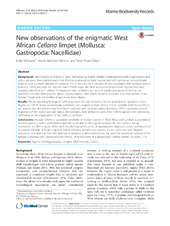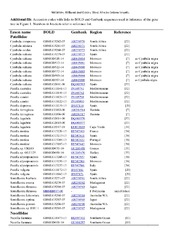| dc.contributor.author | Willassen, Endre | |
| dc.contributor.author | Williams, Akanbi Bamikole | |
| dc.contributor.author | Oskars, Trond Roger | |
| dc.date.accessioned | 2016-08-10T12:22:46Z | |
| dc.date.available | 2016-08-10T12:22:46Z | |
| dc.date.issued | 2016-07-25 | |
| dc.Published | Marine Biodiversity Records 2016, 9(1):60 | eng |
| dc.identifier.issn | 1755-2672 | |
| dc.identifier.uri | https://hdl.handle.net/1956/12541 | |
| dc.description.abstract | Background: Identification of limpets is often hampered by highly variable within-species shell morphologies and colour patterns. Since pre-Linnean times this has produced complex taxonomies with confusing nomenclatorial histories and uncertain distribution patterns. This is the case for a complex of taxa associated with Cymbula safiana (Lamarck, 1819) and with the rejected name Patella nigra. We DNA sequenced limpets from Nigeria that were originally identified as C. safiana. Comparisons with available cox1 data of patellogastropods show that the specimens actually belong to the genus Cellana Adams, 1869 which has been recorded only once before in the Atlantic Ocean with the finding of specimens from Ghana. Results: We are reporting findings of Cellana sp. from the Gulf of Guinea for the second time. Specimens from Nigeria are 100 % similar to previously published cox1 sequences from Ghana. Due to variable shell characteristics we suspect that this species may have been confused with Cymbula safiana (Lamarck, 1819) in previous records. Inspection of the radula sack and radula demonstrates clear similarities with other Cellana species and contrasting differences in the organization of the teeth in Cymbula. Conclusions: Because Cellana is a possible candidate of invasive species in West Africa and Cymbula is considered as endangered, is seems particularly important to be able to distinguish between the two without being dependent on DNA analysis. When shell morphology seems to be of questionable diagnostic value, examination of the radula will help in future mapping and monitoring of these two species. A cox1 gene tree with Nigerian sequences included is in line with findings of previous authors and restates the need for taxonomic revision of the species clustering with Cellana toreuma (Reeve, 1854) and parts of a polyphyletic Cellana radiata von Born, 1778. | en_US |
| dc.language.iso | eng | eng |
| dc.publisher | BioMed Central | eng |
| dc.rights | Attribution CC BY | eng |
| dc.rights.uri | http://creativecommons.org/licenses/by/4.0 | eng |
| dc.subject | Nigeria | eng |
| dc.subject | Patellogastropoda | eng |
| dc.subject | Limpets | eng |
| dc.subject | DNA-barcode | eng |
| dc.subject | Cellana | eng |
| dc.title | New observations of the enigmatic West African Cellana limpet (Mollusca: Gastropoda: Nacellidae) | eng |
| dc.type | Peer reviewed | en_US |
| dc.type | Journal article | en_US |
| dc.date.updated | 2016-07-25T06:03:05Z | |
| dc.description.version | publishedVersion | |
| dc.rights.holder | Copyright 2016 The Authors | eng |
| dc.identifier.doi | https://doi.org/10.1186/s41200-016-0059-9 | |


